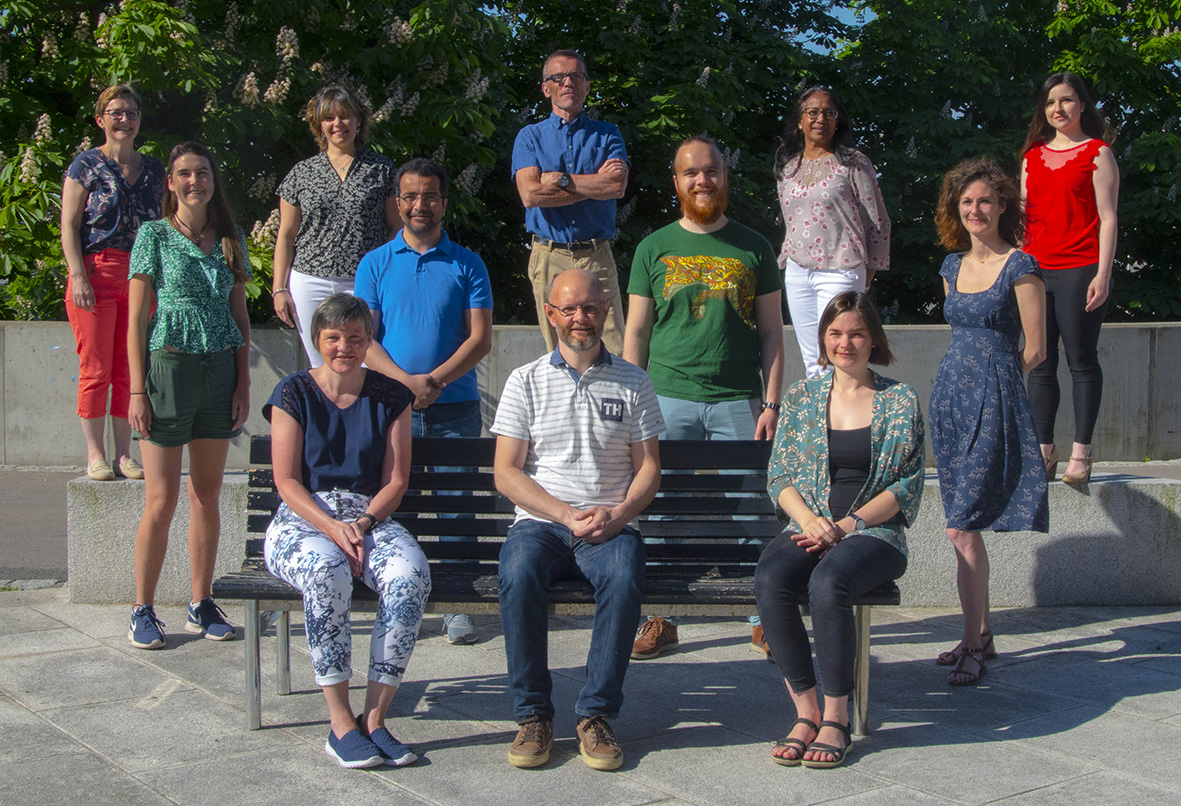Philippe Collas group

Philippe Collas group
Chromatin and nuclear architecture in stem cells
The CollasLab investigates principles of 3-dimensional genome architecture which pattern lineage-specific stem cell differentiation in health and disease contexts.
See also www.collaslab.org.
Research goal
The 3D layout of chromatin plays important roles in the establishment of gene expression programs governing cell fate decisions.We are addressing three main questions:
- How is 3D genome conformation regulated during fat stem cell differentiation?
- How do laminopathy-causing lamin mutations affect chromatin conformation?
- How do histone H3 variants contribute to chromatin homeostasis in normal and cancer cells?
- The lab’s research history in brief
- Our work combines cell biological, genomics and genome structure modeling approaches using patient material and engineered stem cells.
- disassembly and reformation of the nuclear envelope (Steen 2000 J Cell Biol; Steen 2001 J Cell Biol; Martins 2003 J Cell Biol)
- cell and nuclear reprogramming (Håkelien 2002 Nature Biotech; Taranger 2005 Mol Biol Cell; Freberg 2007 Mol Biol Cell)
- chromatin immunoprecipitation (ChIP) assays for small cell numbers (Dahl 2008 Nature Protoc; 2009 Genome Biol)
- epigenetic patterning of developmental gene expression (Lindeman 2011 Dev Cell; Andersen 2012 Genome Biol) and of adipose stem cell differentiation (Boquest 2007 Stem Cells; Sørensen 2010 Mol Biol Cell; Shah 2014 BMC Genomics; Rønningen 2015 BBRC)
- nuclear lamin - chromatin interactions during adipogenic differentiation (Lund 2013 Genome Res; Lund 2014 Nucl Acids Res; Oldenburg 2014 Hum Mol Genet; Rønningen 2015 Genome Res)
- deposition of histone H3 variants into chromatin (Delbarre 2010 Mol Biol Cell; Delbarre 2013 Genome Res; Ivanauskiene 2014 Genome Res; Delbarre 2017 Genome Res)
- 3D genome modeling (Paulsen 2015 PloS Comput Biol; Sekelja 2016 Genome Biol; Paulsen 2017 Genome Biol)Projects:3D organization of the stem cell genomeOngoing research:
- 3D genome organization of the genome influences cell- and time-specific blueprints of gene expression. Some aspects of 3D genome conformation vary between cell types, suggesting developmental regulation. 3D genome conformation entails interactions between chromosomes, forming interactions hubs called topologically-associating domains (TADs). At the nuclear periphery, chromosomes interact with the nuclear lamina through lamin-associated domains (LADs). These interactions are dynamic during differentiation. We are investigating links between cellular metabolism and changes in spatial genome conformation during differentiation of adipose stem cells in normal and pathological conditions.
- Computational methods for 3D and 4D modeling of genome architecture
- Functional relationships between 3D chromatin folding, nuclear envelope-chromatin interactions, epigenetic states and lineage-specific differentiation capacityNuclear lamina, genome organization & adipose stem cell functionOngoing research:
- The nuclear envelope regulates gene expression by interacting with chromatin. It consists of a double nuclear membrane, nuclear pores and the nuclear lamina, a meshwork of A-type lamins (LMNA, LMNC) and B-type lamins (LMNB1, LMNB2). Mutations in LMNA cause laminopathies, which include progeria, muscle dystrophies and partial lipodystrophies. Familial partial lipodystrophy of Dunnigan type (FPLD2) mainly affects adipose tissue and leads to severe metabolic disorders. We use patient cells, patient-derived iPS cells and engineered adipose stem cells to address the impact of lipodystrophic LMNA mutations on differentiation of adipose stem cells (ASCs), formation and composition of LADs and 3D genome conformation.
- Identification of determinants of nuclear envelope-chromatin interactions during lineage-specific differentiation and in laminopathy contexts
- Bioinformatics developmentHistone variants and chromatin homeostasisOngoing research:
- A class of pediatric gliomas (diffuse intrinsic pontine gliomas, DIPGs), is driven by mutations in the H3F3A gene encoding histone variant H3.3. The most prominent DIPG driver H3.3 mutation is H3.3K27M, which results in global reduction of H3K27me3. Other H3.3 mutations include H3.3G34R, which affects other nearby H3 modifications.
- Mechanisms of deposition of histone H3 variants into chromatin
- Role of H3.3 on chromatin homeostasis
- Impact of H3.3 mutations on chromatin and nuclear architecture in glioblastomasKey collaborations
- Louis Casteilla, StromaLab, University of Toulouse, France (adipose tissue metabolism)
- Jacques Grill, Institut Gustave Roussy, Villejuif, France (H3.3 mutations and pediatric glioblastoma)
- Anna Kostareva, Almazov Research Center, St. Petersburg, Russia (mesenchymal stem cells)
- Stefan Pfister, DKFZ, Heidelberg, Germany (pediatric glioblastoma)
- Corinne Vigouroux, Hôpital Saint Antoine, INSERM, Paris, France (lipodystrophies)
- Lee Wong, Monash University, Clayton, Australia (heterochromatin)
- David Tremethick, John Curtis School of Medical Research, Australian National University, Canberra, Australia (genome conformation)Some recent publicationsPaulsen J, Sekelja M, Oldenburg AR, Barateau A, Briand N, Delbarre E, Shah, A, Sørensen AL, Vigouroux C, Buendia B, Collas P. 2017. Chrom3D: three-dimensional genome modeling from Hi-C and nuclear lamin-genome contacts. Genome Biol. 18, 21-29.Rønningen T., Shah A, Oldenburg AR, Vekterud K, Delbarre E, Moskaug JØ, Collas P. 2015. Prepatterning of differentiation-driven nuclear lamin A/C-associated chromatin domains by GlcNAcylated histone H2B. Genome Res 25, 1825-1835.
- Ivanauskiené K., Delbarre E., McGhie J.D., Küntziger T., Wong L.H., Collas P. 2014. The PML-associated protein DEK regulates the balance of H3.3 loading on chromatin and is important for for telomere integrity. Genome Res. 24, 1584-1594
- Sekelja M., Paulsen J., Collas P. 2016. 4D nucleomes in single cells: what can computational modeling reveal about spatial chromatin conformation? Genome Biol 17, 54
- Delbarre, E, Ivanauskiene K, Spirkoski J, Shah A, Vekterud K, Moskaug JØ, Bøe SO, Wong L, Küntziger T, Collas P. 2017. PML protein organizes heterochromatin domains where it regulates histone H3.3 deposition by ATRX/DAXX. Genome Res. In press.
